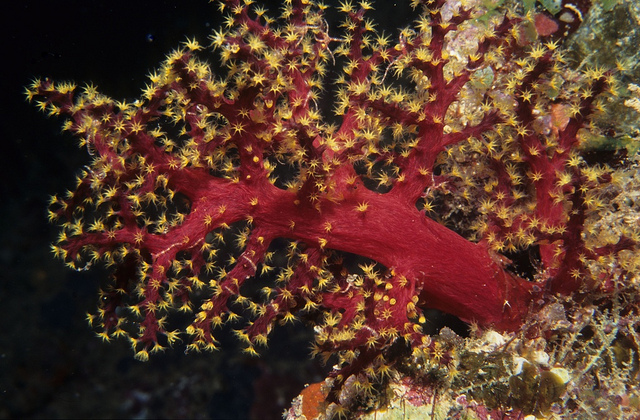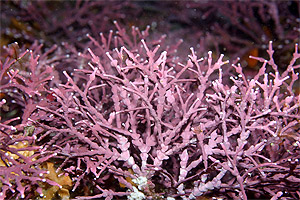Coral Biology, Growth, and Evolution of an Atoll
Before we start, let's consider how reefs grow. The main organism that constructs modern reefs, the coral, includes a number of species belonging to the Cnidaria, a phylum of organisms that uses stinging cells to capture their prey. Modern corals are colonial structures of millions of individual polyps that grow primarily in shallow and clear tropical and subtropical waters, restricted to these areas by light levels and temperatures as well as by nutrients.
Both types of coral reproduce both sexually and asexually. Asexual reproduction involves simple cell division, or budding, and takes place within the colony, whereas sexual reproduction involves the release of gametes into seawater. This is an amazing process that for many species happens once a year, timed by the lunar cycle. The fertilized egg forms a larval planula that settles before forming a new colony.
Video: Coral Reefs 101 National Geographic (3:54)
Intro
NARRATOR: Coral reefs, their bright, vivid colors, can be seen in tropical ocean waters around the globe. Beyond their brilliant appearance lies a hidden significance.
What are corals
Coral are animals. Though they may look like colorful plants, coral are, in fact, made up of tiny animals called polyps. These invertebrates can range from the size of a pinhead to a bit larger than a basketball. Each polyp consists of a soft, saclike body topped by a mouth covered in stinging tentacles. To protect their soft bodies and add support, the polyps secrete limestone skeletons, or calicles.
How do corals grow
Corals are mega builders. Polyp calicles connect to one another, creating a colony that acts as a single organism. As colonies grow over hundreds and thousands of years, they join with other colonies and become reefs that can grow to hundreds of miles long. The largest coral reef is Australia's Great Barrier Reef, which began growing about 20,000 years ago.
Coral reef biodiversity
Coral reefs are some of the most diverse ecosystems on Earth. Though they cover less than 1 percent of the ocean floor, coral reefs are home to 25 percent of all marine creatures. It's been estimated that up to two million species inhabit coral reefs, rivaling the biodiversity of the rain forest. The reefs provide rich habitat that helps protect young fish as they grow.
Coral color
Coral are translucent. Coral reefs get their rainbow of colors from algae, or zooxanthellae, that live in their tissue. Though corals use their tentacles to capture some food, most of their food comes from the algae they house. When coral become stressed by pollution or other factors, they evict their algae. Coral bleaching results, revealing corals' white skeletons. Coral provide a window to the past. As coral grow, their limestone skeletons form layers, similar to tree rings, that vary in composition and thickness based on ocean conditions at the time. With some coral reefs growing for thousands or even millions of years, scientists can study these layers to reveal what the Earth's climate may have been like in the ancient past. Unfortunately, climate change is putting coral's future in danger, along with the millions of species that inhabit the reefs and the half-billion people that rely on reef fish for food. Warming waters result in prolonged coral bleaching that kill coral reefs or leave them vulnerable to other threats. Without significant action on climate change, our oceans could lose many of their colorful reefs by the end of the century.
Large reef structures including fringing and barrier reefs, as well as atolls, represent the growth of these colonies over many thousands or millions of years.
Evolution of an Atoll (1:20)
TIM BRALOWER: Many reefs develop in shallow, tropical, volcanic islands. In this situation, the reef evolves in a manner first described by Charles Darwin. Initially, very few coral polyps will settle upon the volcanic island, but once the volcano becomes dormant, the reef will rapidly colonize the island in a manner called a fringing reef. In the fringing reef, the reef lies right next to the island itself. As the island becomes further eroded, the reef becomes a barrier reef and is separated from the island by a shallow lagoon. This is often what we think about when we think about a tropical island with a reef.
When the island itself becomes completely eroded, we have what is known as an atoll, in which the reef lies along a ring separated by a shallow lagoon in the middle. Many reefs that lie along continents are either fringing reefs, where the reef is right next to the land, or barrier reefs, like the Great Barrier Reef in Australia, where the continent and the reef are separated by some distance.
Examples of modern corals living in symbiosis with dinoflagellate algae called Zooxanthellae
The algae live within the coral polyp and receive CO2 from the polyp that it requires for photosynthesis. Through photosynthesis, the Zooxanthellae convert the CO2 to O2 and provide this vital gas to the coral as well as crucial nutrients. This is important because by removing CO2, the Zooxanthellae drives up saturation which facilitates calcification in the coral skeleton. Reefs are made up of much more than corals and their algal symbionts. Other organisms, including coralline algae (algae that secrete high magnesium calcite and conduct photosynthesis on their own), are active framework builders in modern reefs. Today, sponges, sea anemones, sea urchins, a diverse array of fish, and many other organisms live within reefs, some playing a vital role in building reefs and keeping them healthy and others taking advantage of their decline.


